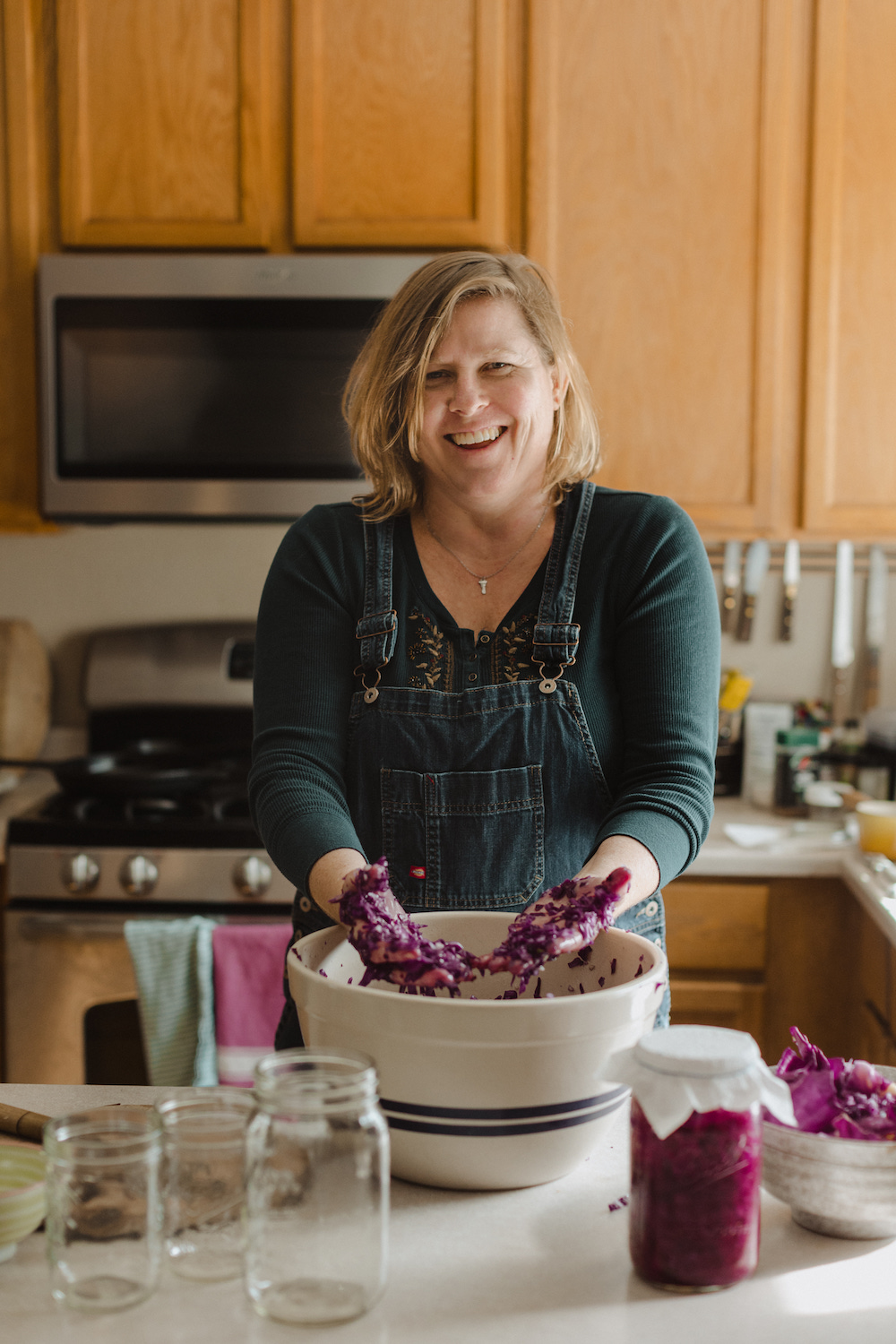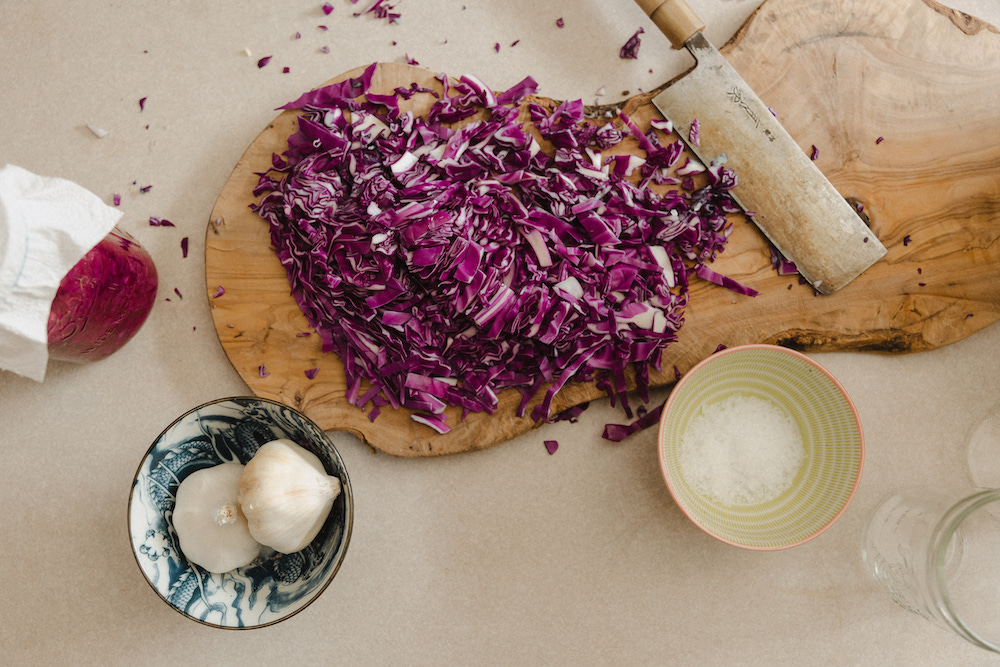Making Garlic Sauerkraut with Sheila Shupe
I’ll admit it. I’m a germ lover. I court the sour flavor and profusion of vitamins they add to veggies. Their complex names seduce me like foreign tropical isles: Coliform, Leuconostoc, Lacticaseibacillus rhamnosus. I lust after a good rhamnosus. I rub them on my body and consume them whenever I can, liquid, solid, mush. Give me a hunk of baked fermented wheat and I will slather cultured butter on that thing faster than you can say bifidobacterium.
Though my inter-species affair really ramped up over the past decade, the preceding 200 years are rife with microbe prejudice and persecution. Ever since Pasteur, germs got a bad rap: they were tiny, they were deadly, they were everywhere. Then in 1907, Russian scientist Elie Metchnikoff was the first to propose the idea of a probiotic, but it wasn’t defined by the World Health Organization until 2001.
Now the word “probiotic” is slapped on labels of everything from body lotion to onion dip, and for good reason. The life-giving properties of these beneficial bacteria not only help your tummy feel better and boost your immune system, they also brighten your skin, sharpen your mind, and up your charcuterie game.
But romance can be expensive. I flirted with the $90 supplements, and I still don’t tell my husband about my $9/pint organic raw golden kefir. But for microbes, cost does not necessarily indicate quality. The best way to capitalize on this relationship is to culture your own. For a buck-fifty head of organic cabbage, 10 minutes of chopping, a week of patience and some salt, you too can start feeling the love.
Sauerkraut means “sour cabbage” in German, but versions of this dish have existed in cultures around the world for millennia. Some say Genghis Khan’s army conquered Asia on rice and pickled cabbage. Makes sense. Culturing a vegetable basically gives it superpowers. Bacteria chew through the sugars and release more vitamins, enzymes, protein and acids than you get by eating the veg alone. Cabbage becomes a powerhouse of vitamins C and K, and a good source of magnesium, fiber, folate, iron, potassium and manganese. Fermentation also makes these nutrients easier for your body to absorb. Studies show pickled cabbage in particular may help fight cancer.
Most of us have experienced the soggy off-white vinegary stuff on the side of a hot dog cart. This recipe, my friends, is not that. When culturing your own veggies, you can get as creative as you like. As long as you have enough salt to kill off unwanted bacteria, you can pickle just about any fruit or vegetable. You can control how soft or sour it gets by how long you let it ferment. Use red cabbage or green, use garlic or not. This is your affair. Let your hair down.
If you are new to sauerkraut or ferments in general and are worried about using up the finished product, don’t be. You can top your eggs with it, throw it on a sandwich or sausage, or amp up your Korean tacos. I had a friend who lived in Germany make a rich and creamy pasta dish by baking bow ties with heavy cream, sauerkraut and Parmesan cheese. Delicious.
It’s best to eat raw, but even the lactic acid created by the ferment is good for us, so toss some in a soup or fling it into a stir fry—anywhere you need some extra tang and texture, this recipe goeth. It will last a few months in your fridge as long as you keep it tucked down in the brine. Crank up the Isaac Hayes and the lava lamp, and get ready to make some babies.
Bacteria babies. By the billions.
MATERIALS
Glass jar or crock
Coffee filter or paper towel Rubber band
Large ceramic or glass bowl
INGREDIENTS
1 red or green cabbage, organic and fresh as possible to get the best bacteria 5-10 cloves organic garlic
1-2 teaspoons salt
INSTRUCTIONS
- Reserve one whole cabbage leaf
- Chop cabbage into slivers (I like mine fine, about a quarter of an inch)
- Chop garlic to a semi-fine chunk
- Place ingredients in a large glass or ceramic bowl
- Sprinkle salt onto the veggies as you go, 1 1/2-2 tsp depending on the size of your cabbage
- Massage the cabbage for 5-10 minutes
- Pack into a mason jar or crock until the juices cover the top of the cabbage (if the juices don’t cover the cabbage after two hours, you can add a little distilled water to cover the top)
- Using a glass fermentation weight or your whole cabbage leaf as a barrier, push the cabbage as far as you can into the liquid to prevent it from touching air
- Cover the jar with a coffee filter, paper towel, or clean dish cloth and use a rubber band to secure it
- Let it sit in a cool dark space for at least three days or up to two months, depending on the sourness you want (the longer it goes, the sourer it gets)
- Pro-tip: a towel under the jar protects your pantry shelves from dark purple juice
- Always be sure the kraut stays below the brine
- Discard cabbage leaf when kraut is ready (sometimes the whole leaf will mold a little, which is why it’s there)



